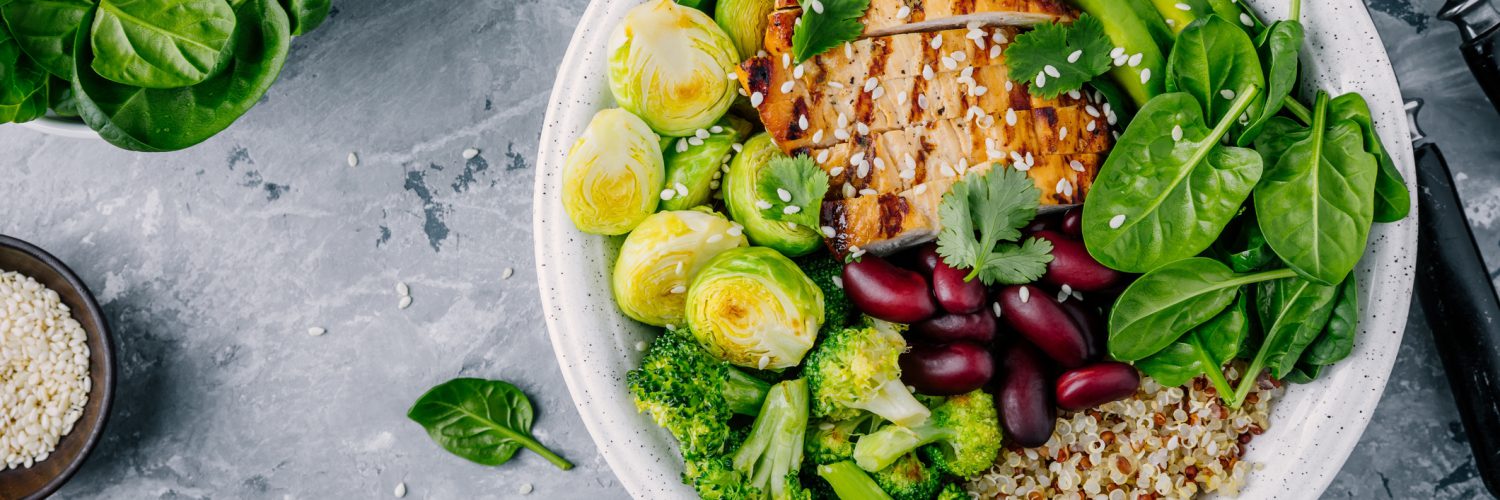While healthy eating is often considered challenging, it is actually very simple! If you’re not doing so already, now is a great time to start thinking about what foods go on your plate and whether your meals are comprised of foods from all the major food groups. So how do you know how much of each food group is the right amount and whether or not you’re eating healthfully? Here are some tips to help you get started on your path toward better eating habits.
MyPlate
This simple rule is helpful to remember at each meal. Make half your plate fruits and vegetables, one quarter protein, and one quarter grains at each meal.
- Fill half your plate with fruits and veggies. A diet rich in fruits and vegetables is key to maintaining a healthy body as they are high in fiber, full of vitamins and a source of carbohydrates. Try to eat fruits and vegetables of varying color for greater nutritional benefit.
- Aim for a quarter of your plate at each meal to be a grain. These foods are carbohydrates, the main source of energy for your body. Make half your grains whole grains for added nutritional benefit. Limit refined grain products such as white bread, baked goods or other sweets.
- Make protein one quarter of your plate at each meal. This macronutrient is essential to the building, maintenance and repair of body tissues including skin, organs and muscles. Choose proteins wisely. Seafood, lean meats, poultry, eggs, nuts and beans are all excellent sources of protein. Limit certain proteins like fatty cuts of beef, pork and high-fat dairy products.
80/20 Rule
Prevent overindulging by allowing yourself to eat unhealthy some of the time. Adopt an 80/20 rule: Eat healthy 80 percent of the time and unhealthy 20 percent. You can improve your eating even further with a 90/10 rule!
Peace Sign
Think of the food you eat at each meal if it was laid out on the form of a peace sign on your plate. Eat mostly whole grains and fruits and vegetables, which would make up the two large upper portions. Include protein and dairy in lesser amounts, which would represent the smaller portions.
The Hunger Scale
This scale ranks physical cues of hunger to help you identify when to eat to prevent overeating. You should still watch what you eat when using this method!
- Starving: You feel weak, dizzy and may feel a burning sensation in your stomach.
- Very hungry: You feel agitated, irritable and have low energy levels.
- Pretty hungry: Your stomach is starting to growl.
- Beginning of hunger: You will start feeling the need to eat, but you can wait.
- Satisfied: You are content, neither hungry nor full.
- Slightly full: You feel a little full, but comfortable.
- Slightly uncomfortable: Hunger is gone, but you feel a little uncomfortable.
- Stuffed: You feel like you ate too much.
- Very uncomfortable: Your stomach may hurt and you feel like you might get sick.
- Overstuffed: You feel so full you are sick.
Aim to eat when your hunger is at a 3 or 4 and stop eating when you’re at a 5 or 6.
Other helpful tips to keep in mind on your quest to healthy eating:
Be smart about beverages to limit unnecessary calories and sugar.
- Drink more water. Water provides hydration with no calories, fat or sugar.
- Limit milk/dairy to 1 to 2 servings per day; choose options that are low in fat.
- Avoid sugary beverages like those made from powdered mixes, fruit punch, lemonades, sweetened iced tea, soda, etc.
Focus on healthy fats. Certain types of fats are essential components of a healthy diet.
- Eat foods high in healthy monounsaturated, polyunsaturated and omega-3 fatty acids like nuts, fish and oils such as olive and canola oil.
- Limit foods that are high in saturated fats and trans fats such as those found in animal products, butter or hard margarine, and baked goods.



